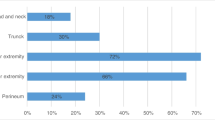Abstract
Exposure to high-voltage electric arcs as a result of an accident or by means to commit suicide can affect people’s health and cause death. There are characteristic external findings that can be found on external examination. These include extensive skin burns, periorbital recesses or “crow’s feet,” vapor deposition of conductor material, known as metallization, and tightly spaced, roundish, crocodile skin like burns. The Institute of Legal Medicine of the Rostock University Medical Center recorded 16 deaths caused by exposure to electricity between 1990 and 2018. Six of these deaths were caused by exposure to high-voltage electric arcs and five of these deaths (83 %) showed crocodile skin like burns and one had periorbital recesses burns on the face as a result of a fault arc. To our knowledge, the present paper is the first report describing the frequent occurrence of crocodile skin like burns due to high-voltage fault arcs.












Similar content being viewed by others
References
Anders S, Tsokos M, Püschel K (2002) Nachweis der Stromwirkung und des Stromweges im Körper. Rechtsmedizin 12:1–9
Andrews CJ, Cooper MA (1992) Clinical presentation of the lightning victim. In: Andrews CJ, Cooper MA, Darvenzia M, Mackerras D (eds) Lightning injuries: electrical, medical, and legal aspects. CRC Press, Boca Raton, pp 47–70
Angerer F, Hoppe U, Schick B (2009) Blitzeinschlag in einen PKW mit Schädigung des Hörorgans. HNO 57:1081–1084
Berufsgenossenschaft Energie Textil Elektro Medienerzeugnisse (2019) Statistik der Stromunfälle. In: https://www.bgetem.de/arbeitssicherheit-gesundheitsschutz/institute/institut-zur-erforschung-elektrischer-unfaelle/statistik-der-stromunfaelle. Accessed 06 Aug 2019
Bielefeld L, Mierdel K, Pollak S, Große Perdekamp M (2013) Electrothermic damage to the nail due to arcing in discharge. Forensic Sci Int 233:149–153
Boozalis GT, Purdue GF, Hunt JL, McCulley JP (1991) Ocular changes from electrical burn injuries. A literature review and report of cases. J Burn Care Rehabil 12:458–462
Bundesamt für Strahlenschutz (2019) In: http://www.bfs.de/DE/themen /opt/uv/wirkung/einfuehrung/einfuehrung.html. Accessed 18 Mar 2019
Bundesamt für Strahlenschutz (2019) In: http://www.bfs.de/DE/themen/opt/ir/wirkung/wirkung.html. Accessed 18 Mar 2019
Cancio LC, Jimenez-Reyna JF, Barillo DJ, Walker SC, McManus AT, Vaughan GM (2005) One hundred ninety-five cases of electric injury. J Burn Care Rehabil 26:331–340
Cooper MA (1995) Emergent care of lightning and electrical injuries. Semin Neurol 15:268–2788
Herold K (1960) Der Elektrotod. In: Prokop O (ed) Lehrbuch der gerichtlichen Medizin. Volk und Wissen, Berlin, pp 127–141
Hettiaratchy S, Dziewulski P (2004) Pathophysiology and types of burns. Br Med J 328:1427–1429
Internationale Vereinigung für Soziale Sicherheit (International Social Security Association ISSA) (2018) Leitlinie für die Auswahl von persönlicher Schutzausrüstung gegen thermische Auswirkungen eines Störlichtbogens. http://etf.bgetem.de/htdocs/r30/vc_shop/bilder/firma53/ivss_001d_a04-2012.pdf. Accessed 06 Dec 2018
Jellinek S (1903) Elektropathologie. Enke, Stuttgart
Knight B (1991) Forensic Pathology. Edward Arnold, London Melbourne Auckland
Koeppen S, Panse F (1955) Klinische Elektropathologie. Thieme, Stuttgart
Kupfer J, Funke K, Erkens R (1987) Elektrischer Strom als Unfallursache. Tribüne, Berlin
Lakosha H, Tremblay F, De Becker I (2009) electrical trauma to the eye. Can J Ophthalmol 44:605–606
Lifschultz BD, Donoghue ER (1993) Electrical and lightning injuries. In: Spitz WU (ed) Medicolegal investigation of death, 3rd edn. Thomas, Springfield, pp 516–527
Pollak S (1980) Pathomorphologische Befundkonstellationen beim Tod durch hochgespannten elektrischen Strom. Arch Kriminol 165:1–16
Pollak S (2000) Verkennung von tödlichen Hochspannungs- und Blitzunfällen. Arch Kriminol 206:168–179
Pollak S, Thierauf A (2015) Elektrotraumen, Blitzschlag. In: Madea B (ed) Rechtsmedizin. 3. Aufl. Springer, Berlin, pp 324–332
Schau H, Halinka A, Winkler W (2008) Elektrische Schutzeinrichtungen in Industrienetzen und -anlagen. Hüthig und Pflaum, München
Schwerd W (1992) Rechtsmedizin. Deutscher Ärzte-Verlag, Köln
Searle J, Slagman A, Maaß W, Möckel M (2013) Cardiac monitoring in patients with electrical injuries - an analysis of 268 patients at the Charité hospital. Dtsch Arztebl Int 110:847–853
Sellier K (1975) Schäden und Tod durch Elektrizität. In: Mueller B (ed) Gerichtliche Medizin. Teil 1, 2. ed. Springer, Berlin, pp 538–563
Shih JG, Shahrokhi S, Jeschke MG (2017) Review of adult electrical burn injury outcomes worldwide: an analysis of low-voltage versus electrical injury. J Burn Care Res 38:e293–e298
Spielmann H (1999) Toxikologie. In: Oberdisse E, Hackenthal E, Kuschinsky K (eds) Pharmakologie und Toxikologie, 2nd edn. Springer, Berlin, pp 708–747
Statista (2019) Nettostromverbrauch in Deutschland in den Jahren 1991 bis 2018 (in Terrawattstunden). In: https://de.statista.com/statistik/daten/studie/ 164149/umfrage/netto-stromverbrauch-in deutschland-seit-1991. Accessed 07 Aug 2019
Waldmann V, Narayanan K, Combes N, Marijon E (2017) Electrical injury. Br Med J 357:j1418
Weimann W, Prokop O (1963) Atlas der gerichtlichen Medizin. Volk und Gesundheit, Berlin
Wetli CV (1996) Keraunopathology. Am J Forensic Med Pathol 17:89–98
Zack F, Raphael T, Kupfer J, Jokuszies A, Vogt PM, Büttner A, Püschel K, Schalke B, Todt M, Dettmeyer R (2013) Vier Todesopfer nach einem Blitzunfall auf einem Golfplatz. Rechtsmedizin 23:114–118
Author information
Authors and Affiliations
Corresponding author
Additional information
Publisher’s note
Springer Nature remains neutral with regard to jurisdictional claims in published maps and institutional affiliations.
Rights and permissions
About this article
Cite this article
Zack, F., Schau, H., Dalchow, A. et al. Lesions and characteristic injury patterns caused by high-voltage fault arcs. Int J Legal Med 134, 1353–1359 (2020). https://doi.org/10.1007/s00414-019-02173-3
Received:
Accepted:
Published:
Issue Date:
DOI: https://doi.org/10.1007/s00414-019-02173-3




